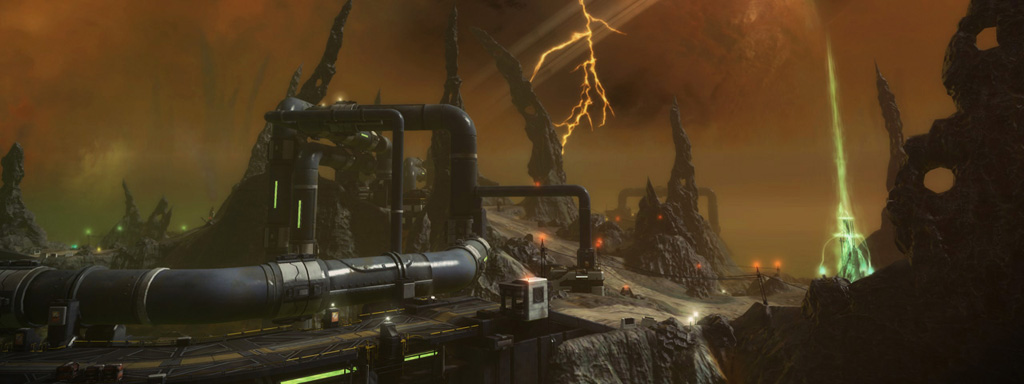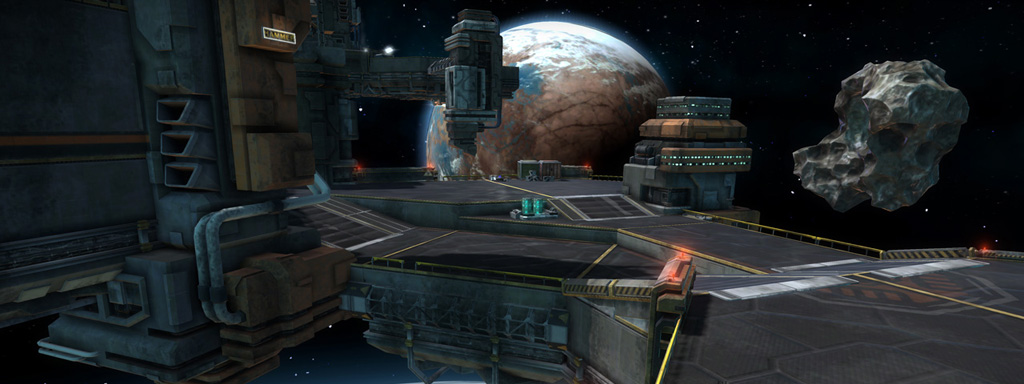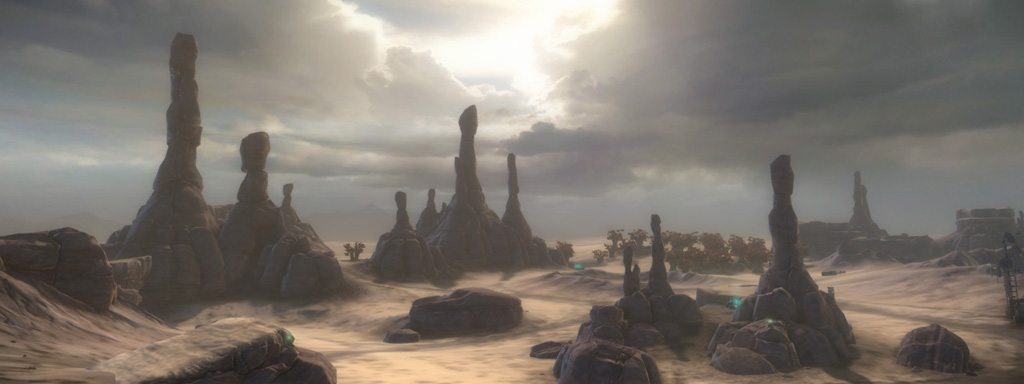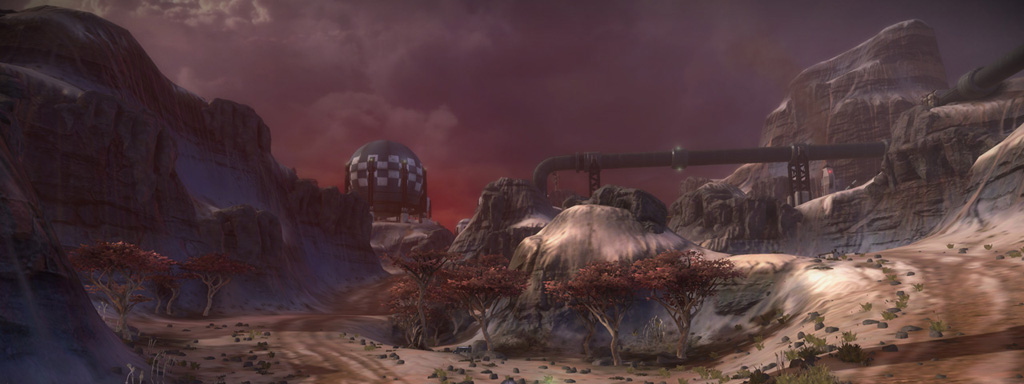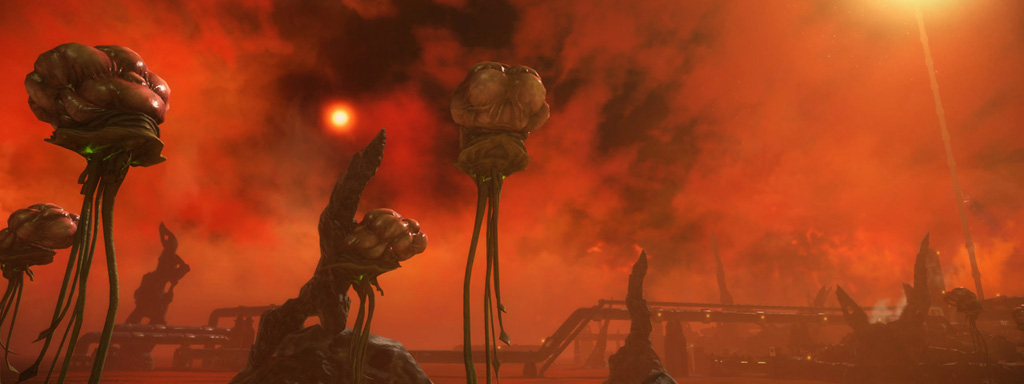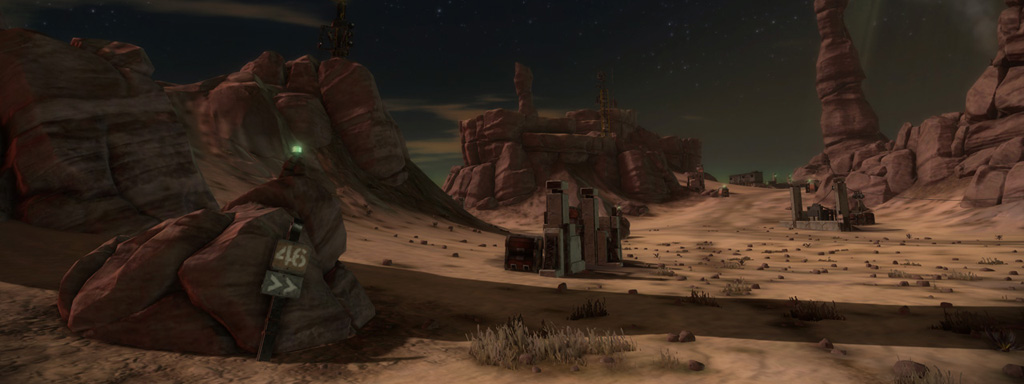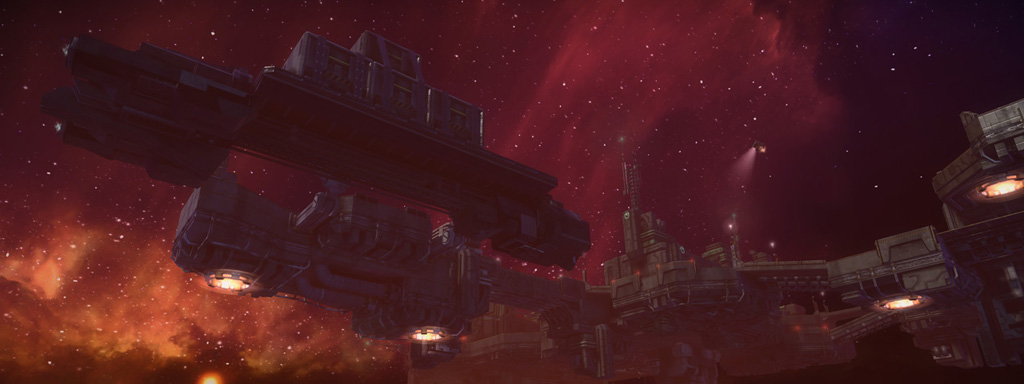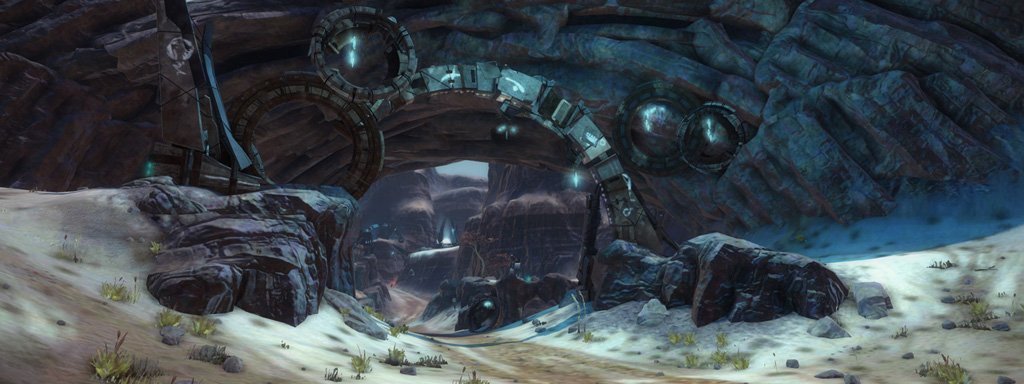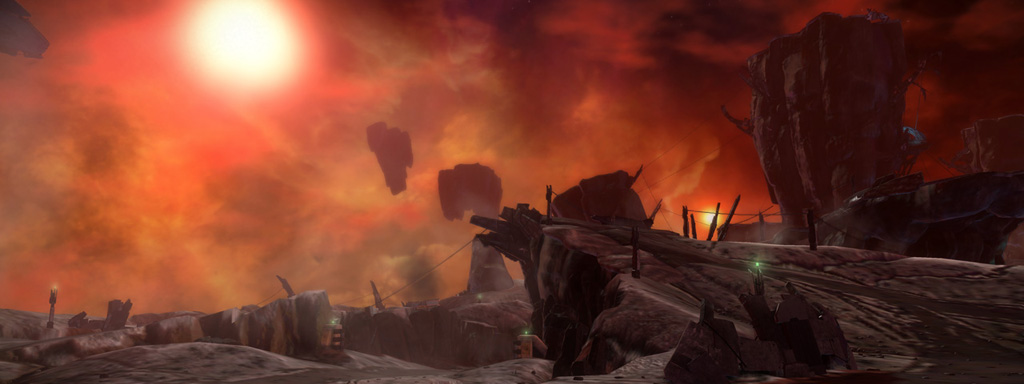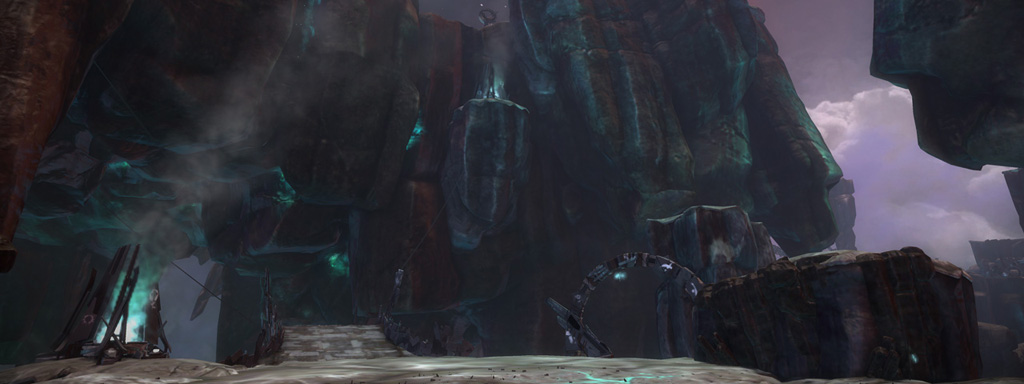Conduit
Conduit, set in the "Acid Sea" environment of Dust's moon Scourge, was the general public's first glimpse of Starhawk's multiplayer. The level debuted to the press at our unveil event at the Alamo Drafthouse Ritz in May 2011 and then to the general public at E3 2011. Conduit was also included in both phases of the Starhawk beta that kicked off in late 2011.
This was actually the second attempt at an Acid Sea-themed multiplayer level. The first was the layout that would eventually become Cove, which was deemed too large for sixteen-player servers in our unveil and early stages of the beta. Conduit's layout focuses around a large land mass with a central plateau, providing a key midground for CTF play. The side islands connected by bridges provide alternate routes (and additional rift locations for Zones).
I made one significant layout change to the central plateau during the beta. My original plan had called for a unique asset in the center with the large pipe structures socketed into the sides. That asset was de-scoped and replaced with a pair of large square platforms, but their sharp edges and awkward ramp positioning made navigation a chore. I pulled these two buildings apart and socketed them underneath the pipe structures, then added a standalone ramp to allow access from both sides. This resulted in greatly improved layout flow, more interesting Build & Battle strategies, and much better placement of the central rift in Zones.
Starhawk
May 2012
Layout
Andrew Weldon
Environment
Jon Galloway, Stephen Daniele
Orbital
Orbital made its debut at E3 2011 and was playable at the Sony booth on the show floor. In addition to putting the "star" in Starhawk multiplayer, it served as players' first introduction to the Vulture Jet Pack. Orbital became the second map featured in the Starhawk private beta in November 2011.
Starhawk's space levels were interesting beasts to construct. Unlike the terrestrial levels, which relied on terrain rendered in World Machine, our space levels were constructed from individually-placed platform meshes. This was a double-edged sword; editing and iteration became much easier without the need for tedious rendering and conversion, but were hell on object count and performance. This resulted in smaller, more compact layouts - the space levels ended up being the smallest levels in the shipping game.
The floating side platforms off each base turned into brutal spawn camping points during the private beta, as players would build Bunkers and land Hawks, raining rockets and missiles down on the opposing team's base. For the public beta and final relase, I rotated this entire platform and moved the platform's tower to block line of sight between the main platform and the opposing base. A smaller floating platform in between provided additional LOS blockage to the back of the base and provided cover for jetpacking defenders to mount a counter-attack on the platform.
Starhawk
May 2012
Layout
Andrew Weldon
Environment
LightBox Interactive
Basin
Basin is a sprawling 32-player level on the barren world of Dust and the largest pure terrestrial level featured in Starhawk. Players got their first glimpse of the level when Starhawk's Public Beta launched in January 2012. Additionally, this level served as the first introduction to the Sidewinder Jet Bike and Ox Heavy Tank vehicles.
The planet Dust is central to to Starhawk's story and the most literal interpretation of the western influences on the game. This style lends itself very well to vast open terrain with sweeping routes and is the perfect location to showcase the Sidewinder. I built much of this level with massive Sidewinder and Razorback jumps in mind, such as the twin ramp plateaus framing the front entrance to each base. What the level boasts in ground excitement, though, it lacks in flight - the massive hoodoo structures provide limited flight cover, but overall this layout leaves Hawks massively exposed and vulnerable to ground fire and other dogfighters.
The crater in the center of the level is actually my oldest work on Starhawk. The first World Machine terrain I created after being hired in September 2009 was a large hand-crafted crater made of polygon shapes. The crater was a hit with everyone, but languished for almost two years before being resurrected as the midground of this layout. I lost some fidelity due to shrinking the crater to fit this level and some more aggressive erosion settings, but in the end it remains one of the more notable pure terrain features in the game.
Starhawk
May 2012
Layout
Andrew Weldon
Environment
Jon Galloway, Stephen Daniele, Lars DeVore
Narrows
While not released until Starhawk's retail debut, Narrows is the game's oldest multiplayer level. While this is often a strike against a level, in this case I was able to take advantage of the extra time and make a few extra iterations on the terrain layout. Those extra revisions resulted in (arguably) the strongest MP layout in the shipping game.
Early versions of this level had a sixth Rift location between the three large spires. This was great for integrating the spires into the play space vs. the mostly inaccessible side landmarks they became, but it was so isolated from the rest of the layout that it was rarely used in playtests. I removed the area and re-routed the roads to create the long winding "high road" route across the midground.
One other failed experiment from early drafts of this layout was an attempt at combining symmetric CTF and asymmetric Zones layouts into the same terrain. In addition to the core layout, I added two unique bases with a pair of connecting routes: one to the southwest, below the Rifter base, and one to the northeast, above the Outcast base. While it was an interesting idea and showed promise, ultimately I backed off the idea for time, scope, and complexity reasons. The northeast area disappeared entirely, while I mirrored the southwest area to the southeast corner of the map - these became the initial expansion Rift areas for both teams in Zones.
Starhawk
May 2012
Layout
Andrew Weldon
Environment
Jon Galloway, Stephen Daniele
Cove
Cove was designed as the featured multiplayer map for our unveil until size concerns temporarily shelved it in favor of Conduit. Unlike Conduit's rotational symmetry, this level is mirrored vertically into a horseshoe-shaped layout. A trio of low, middle, and high routes extend east onto a large plateau, while a single low route hooks around a pair of bridges on the west side of the level, meeting in a small central island. The namesake central cove is split by a single winding bridge that provides a tempting but dangerous shortcut for CTF.
My intention had always been that the east ridge would feature heavier man-made structures compared to more natural low-lying areas to the west. I temporarily borrowed the "Ballard's Crossing" space elevator from the single player campaign to provide a visual anchor to the top of the central plateau, but this never quite came together as strongly as I'd hoped.
When the frequently-linked Matthew Breit was tasked with building the space elevator platform for "The Pipeline," however, we had a perfect opportunity. Matt was kind enough to build that mission's platform in a modular structure that fit the terrain I already had established here, which allowed me to easily socket the new elevator into this layout with only minor adjustments. The extended front of the space elevator platform I added in this map provides a great overlook across the central bridge, and was the perfect spot to add a a sixth rift to the layout for Zones mode.
Starhawk
May 2012
Layout
Andrew Weldon
Environment
Matthew Breit, Jon Galloway
Outlands
Outlands is the smallest terrestrial level in Starhawk and maybe the fastest-paced map in the original game. Like Basin, Outlands is a haven for Sidewinders with wide open spaces and numerous jumps. The level is also (intentionally) a meatgrinder in Zones, featuring only three rifts.
While LightBox artists typically handled most of the final detailing passes on our levels, due to end-of-project workloads I was able to swipe most of this level for myself, with Jonathan Lindblom stepping in for the finishing touches when I had to finish the remaining MP levels for launch. I particularly enjoyed assembling the various little cover walls throughout the level, a style I borrowed from Creative Director Lars DeVore's work on Basin. The destroyed work site in the center of the level was also fun to piece together and, at points, came much closer to the level of density I'm used to from FPS level design.
The eclipse sky featured in this level was originally developed for Basin, but we felt that introducing our new level in a dark and brownish lighting scheme wouldn't do us any favors, especially against darker levels like Conduit and Orbital. We swapped the two skies a couple weeks before submitting our Public Beta build, and the change ended up being permanent.
Starhawk
May 2012
Layout
Andrew Weldon
Environment
Andrew Weldon, Jonathan Lindblom, Jon Galloway
Apogee
Outlands is the smallest terrestrial level in Starhawk and maybe the fastest-paced map in the original game. Like Basin, Outlands is a haven for Sidewinders with wide open spaces and numerous jumps. The level is also (intentionally) a meatgrinder in Zones, featuring only three rifts.
While LightBox artists typically handled most of the final detailing passes on our levels, due to end-of-project workloads I was able to swipe most of this level for myself, with Jonathan Lindblom stepping in for the finishing touches when I had to finish the remaining MP levels for launch. I particularly enjoyed assembling the various little cover walls throughout the level, a style I borrowed from Creative Director Lars DeVore's work on Basin. The destroyed work site in the center of the level was also fun to piece together and, at points, came much closer to the level of density I'm used to from FPS level design.
The eclipse sky featured in this level was originally developed for Basin, but we felt that introducing our new level in a dark and brownish lighting scheme wouldn't do us any favors, especially against darker levels like Conduit and Orbital. We swapped the two skies a couple weeks before submitting our Public Beta build, and the change ended up being permanent.
Starhawk
May 2012
Layout
Andrew Weldon
Environment
Matthew Breit
Lost Canyon
At its simplest level, Lost Canyon took inspiration from the concept of levels like Halo's famed "Blood Gulch:" base here, base there, meatgrinder in the middle. The land bridge serves as a visibility blocker between bases, a key shortcut between the side Rifts in Zones, and has even been used effectively on occasion as home to Outposts, Sniper Towers, and Turrets. Like Outlands, this map is fast and chaotic.
The Canyon levels suffer from a bit of a size and scale dilemma; while this is the "smaller" layout, it actually takes up nearly as much surface area as Narrows. One change I considered during development would have stripped the side paths and re-routed the overlook road to cross the bottom of the basin. This would have created an overlapping figure-eight layout and emphasized a key Build and Battle choke point in the middle, but time was tight and the layout was playing quite well already.
The flags in CTF were originally placed on the front platform of each base (a custom variant made for this level by Matthew Breit), but this broke their intended design, which was to allow hilarious Razorback/Sidewinder jumps into the central basin. With the flag on the front, players had to exit their vehicles to pick up the flag, re-mount, and then awkwardly fall off the front at slow speed. Moving the flags to the back platforms allowed this escape route to exist as intended.
Starhawk
May 2012
Layout
Andrew Weldon
Environment
Jon Galloway, Steven Daniele
Hollow
The Sever, or "shattered moon" environment, was the most challenging Starhawk environment to bring to life. In Starhawk's lore, this moon of Dust was torn apart by rift energy, and serves as the lair of the Outlaw and Outcast war bands in the campaign.
Our terrain workflow relied on heightfield-based terrain, which complicated the matter creating floating islands. Our solution was to skim the top off our World Machine terrain output, then use hand-modeled rock geometry to cover the sides and bottoms. I planned out the island shapes I wanted (to scale!) in Photoshop before Lead 3D artist Jon Galloway worked them into the full World Machine terrain template and our other artists began building the lower shells. These islands were designed to take up half the texture memory of a normal terrain and could be duplicated in the scene for symmetry, freeing up more memory for the shells and other massive rock meshes and textures.
We went back and forth a bit on how to construct the terrain layout itself; I was able to work up a way to lay out large cracks in the terrain, which Jonny then fleshed out and detailed in the final terrain pass. This cracked look helped create Hollow's low-lying slot canyons as well as ramps allowing vehicles to jump over the gap in between.
Hollow's unique layout feature is the central floating island that serves both as a visibility blocker between bases and a valuable overlook base for Build & Battle expansion. Despite its ridiculous elevation, I was able to affix a couple ramps to either end, creating the opportunity for the most dangerous vehicle jump in the game—just don't try it in the slow-moving Ox Heavy Tank.
Starhawk
May 2012
Layout
Andrew Weldon
Environment
Jon Galloway, Jonathan Lindblom
Fracture
Fracture is the larger of the two Sever levels in Starhawk, and the most massive level in the game. Perhaps too massive, in fact; while the raw terrain size isn't much larger than Basin, the effective playable space is much larger, then spread further apart by bridges. This results in very low player density on all but the most packed servers.
Where Hollow used flat terrain islands, Fracture's massive islands are all rotated off-kilter, adding extra challenge to developing the World Machine layout. To offset this, I used the same approach I used on Hollow to generate the cracked look and instead created large outcroppings sloped such that they would be roughly "flat" when applied to the island as placed in-game. Both teams' bases sit on the edge of massive outcrops at either end of the map, creating an imposing approach from the bottom and once again resulting in impressive vehicle jumps on the way out.
My favorite part of Fracture is actually its underside; a pair of bridges extend from the bases to protected islands underneath to create a long protected low-route for flag runs. These bridges are the only direct land route to the low island in the center which is, thanks to the towering rock walls on either side, an imposing area and a valuable central rift location in Zones.
While the level's sheer size is tricky to deal with, Fracture does stand as the best pure flight layout in the game at launch. The ability to fly under, around, and through the broken up islands leads to some of the most intense dogfights available in Starhawk.
Starhawk
May 2012
Layout
Andrew Weldon
Environment
Jon Galloway, Stephen Daniele
